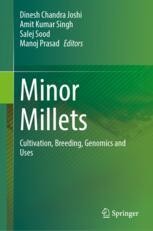Thank you, David, for sharing information on this new publication. Have you had the chance to look at it, and if so how does it compare with other recent publications on the same topic?
One question I have is regarding terminology. The "major" / "minor" distinction among millets is an old one, but I was given to understand that the field was moving to the term "small millets" for the latter.
But apparently that is not a standard term?
Another question I'll post separately about finger millet.
It is good to share information on publications. I did a search on books about millets in 2024 and 2025, and there are a number of possible interest that I'll pass on - but anyone else is welcome to beat
me to it!
Don
DO, EL, MI, US
NAMA
On Wed, May 21, 2025 at 10:32 AM Brenner, David (CTR) - REE-ARS <david.brenner@usda.gov> wrote:
This electronic message contains information generated by the USDA solely for the intended recipients. Any unauthorized interception of this message or the use or disclosure of the information it contains may violate the law and subject the violator to civil or criminal penalties. If you believe you have received this message in error, please notify the sender and delete the email immediately.
